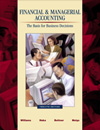Chapter 21 - Summary LO 1 Distinguish among cost centers, profit centers, and investment centers. A cost center is a responsibility center that incurs costs (or expenses) but
does not directly generate revenue. A profit center is a business center that
generates both revenue and costs. Some profit centers are also considered investment
centers. An investment center is a profit center for which management is able
to measure objectively the cost of assets used in the center's operations. LO 2 Explain the need for responsibility center information and describe a responsibility
accounting system. Responsibility center information presents separately the operating results
of each business center within an organization. A responsibility accounting
system shows the performance of the center under each manager's control. LO 3 Prepare an income statement showing contribution margin and responsibility
margin. In responsibility income statements, revenue is assigned to the profit center
responsible for generating that revenue. Two concepts are used in assigning
and classifying expenses. First, each center is charged only with those costs
directly traceable to the center. Second, costs charged to the center are subdivided
between the categories of variable costs and fixed costs. Subtracting variable
costs from revenue indicates the center's contribution margin; subtracting traceable
fixed costs indicates the responsibility margin. LO 4 Distinguish between traceable and common fixed costs. A cost is traceable to a particular center if that center is solely responsible
for the cost being incurred. Traceable costs should disappear if the center
is discontinued. Common costs are not traceable to a particular center. Thus
common costs will not disappear if the center is discontinued. LO 5 Explain the usefulness of contribution margin and responsibility margin in
making short-term and long-term decisions. Fixed costs generally cannot be changed in the short run. Therefore, the effects
of short-run strategies on operating income are equal to the change in contribution
margin (revenue less variable costs). In the long run, however, strategies may
affect changes in the fixed costs traceable to a business center. Therefore,
the profitability of long-run strategies may be evaluated in terms of changes
in responsibility margin (revenue less variable costs and less traceable fixed
costs). LO 6 Describe three transfer pricing methods and explain when each Is useful. Transfer prices are the dollar amounts used by the supplying and buying divisions
within a company to record the exchange of a good or service. When an external
market exists for the product or service, then most companies use the market
price as the transfer price. When no external market exists, then companies
use either negotiated transfer prices or cost-plus transfer prices. Negotiated
transfer prices are used when the buying and supplying divisions can agree on
a transfer price. Where negotiation is too costly or not possible many companies
add a predetermined mark-up to the supplying division's total cost to determine
the transfer price. *LO 7 Explain the differences between full costing and variable costing. Under full costing, fixed manufacturing costs are viewed as product costs and
are included in the cost of finished goods manufactured. Under variable costing,
fixed manufacturing costs are treated as period expenses. An income statement
prepared on a variable costing basis is useful for cost-volume-profit analysis;
however, variable costing is not acceptable for use in published financial statements
or income tax returns. *LO 8 Use a variable costing income statement in CVP analysis. In a variable costing income statement, costs are subdivided into the classifications
of variable costs and fixed costs. This classification permits arranging an
income statement in a manner showing subtotals for contribution margin and total
fixed costs - two key amounts in cost-volume-profit analysis. One purpose of this chapter is to "tie together" many of the concepts
introduced in the preceding management accounting chapters. Notice, for example,
how such concepts as the distinction between variable costs and fixed costs,
cost-volume-profit relationships, the nature of period costs and product costs,
and the flow of manufacturing costs through an accounting system have played
major roles in our evaluation of a responsibility center's performance. In the
next chapter, we introduce the topic of budgeting. The budget provides one of
the major standards with which current performance is compared. | 


 2002 McGraw-Hill Higher Education
2002 McGraw-Hill Higher Education